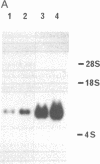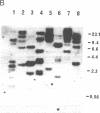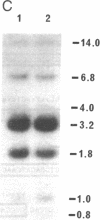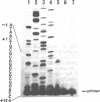Abstract
rig (rat insulinoma gene) was first isolated from a cDNA library of rat insulinomas and has been found to be activated in various human tumors such as insulinomas, esophageal cancers, and colon cancers. Here we isolated the human homologue of rig from a genomic DNA library constructed from a human esophageal carcinoma and determined its complete nucleotide sequence. The gene is composed of about 3000 nucleotides and divided into four exons separated by three introns: exon 3 encodes the nuclear location signal and the DNA-binding domain of the RIG protein. The transcription initiation site was located at -46 base pairs upstream from the first ATG codon. The 5'-flanking region of the gene has no apparent TATA-box or CAAT-box sequence. However, two GC boxes are found at -189 and -30 base pairs upstream from the transcription initiation site and five GC boxes are also found in introns 1 and 2. The gene is bounded in the 5' region by CpG islands, regions of DNA with a high GC content and a high frequency of CpG dinucleotides relative to the bulk genome. Furthermore, the human genome contains at least six copies of RIG pseudogenes, and four of them have the characteristics of processed pseudogenes. From these results together with the finding that RIG is expressed in a wide variety of tissues and cells, we speculate that RIG belongs to the class of "housekeeping" genes, whose products are necessary for the growth of all cell types.
Full text
PDF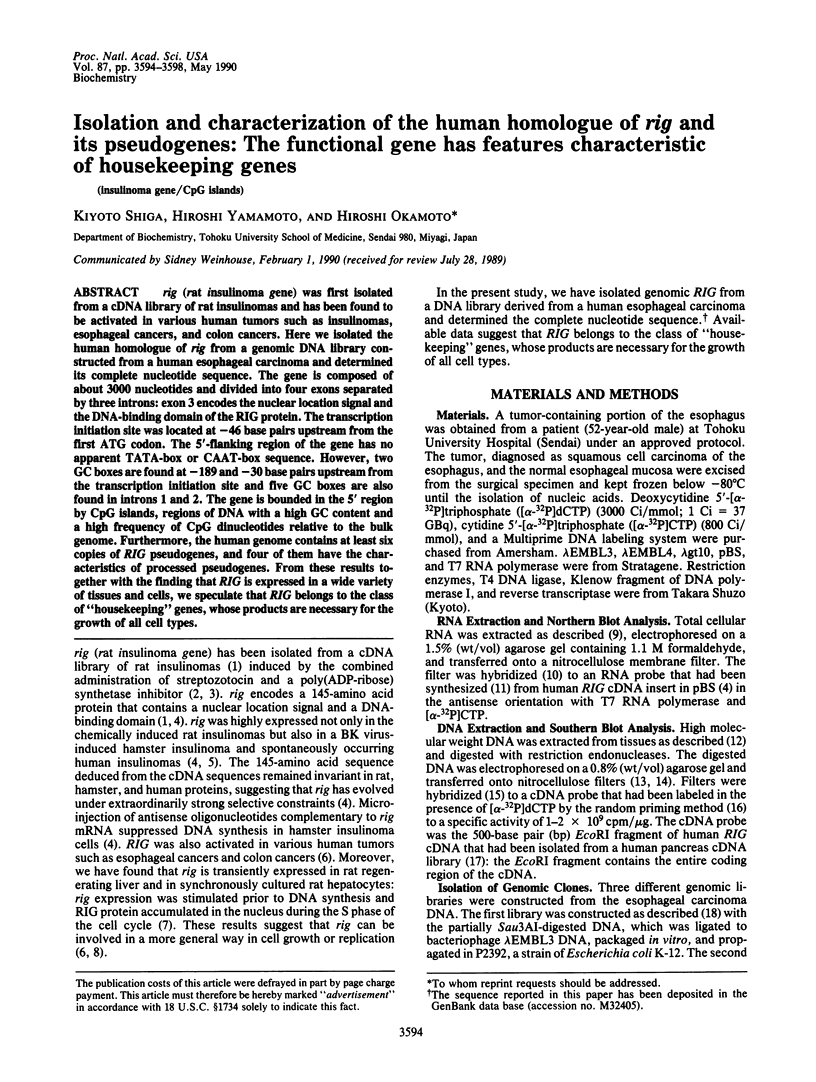
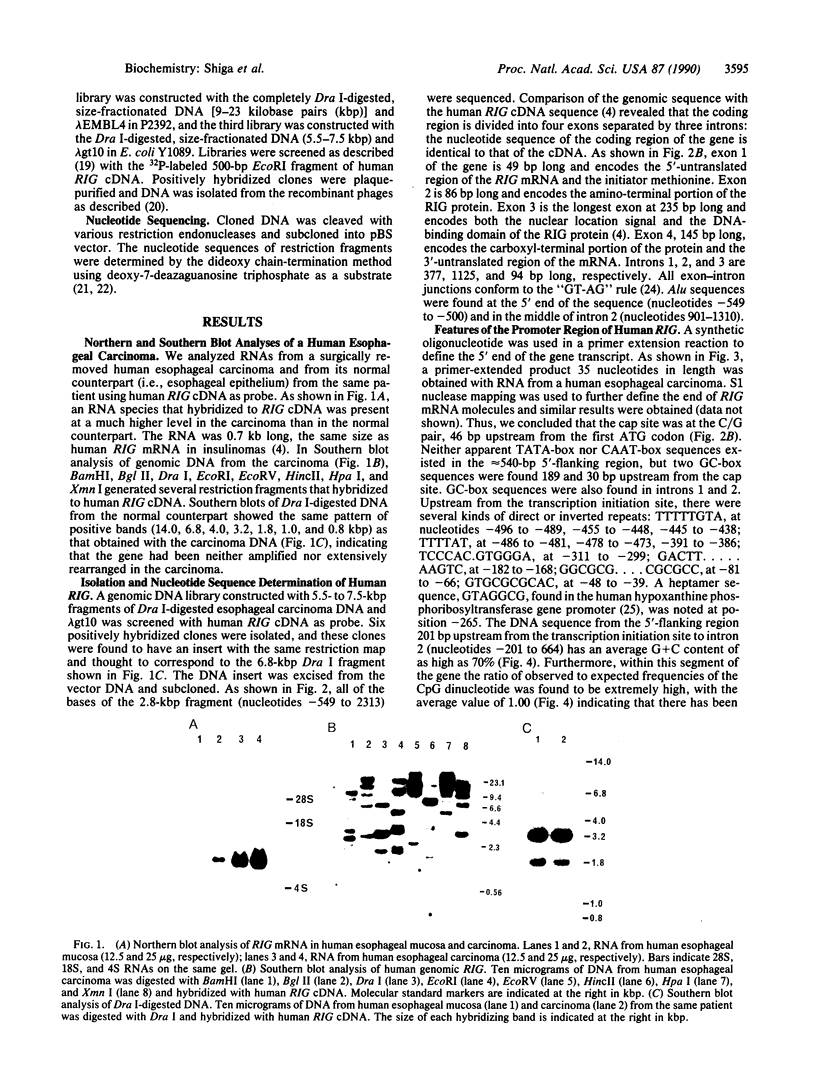
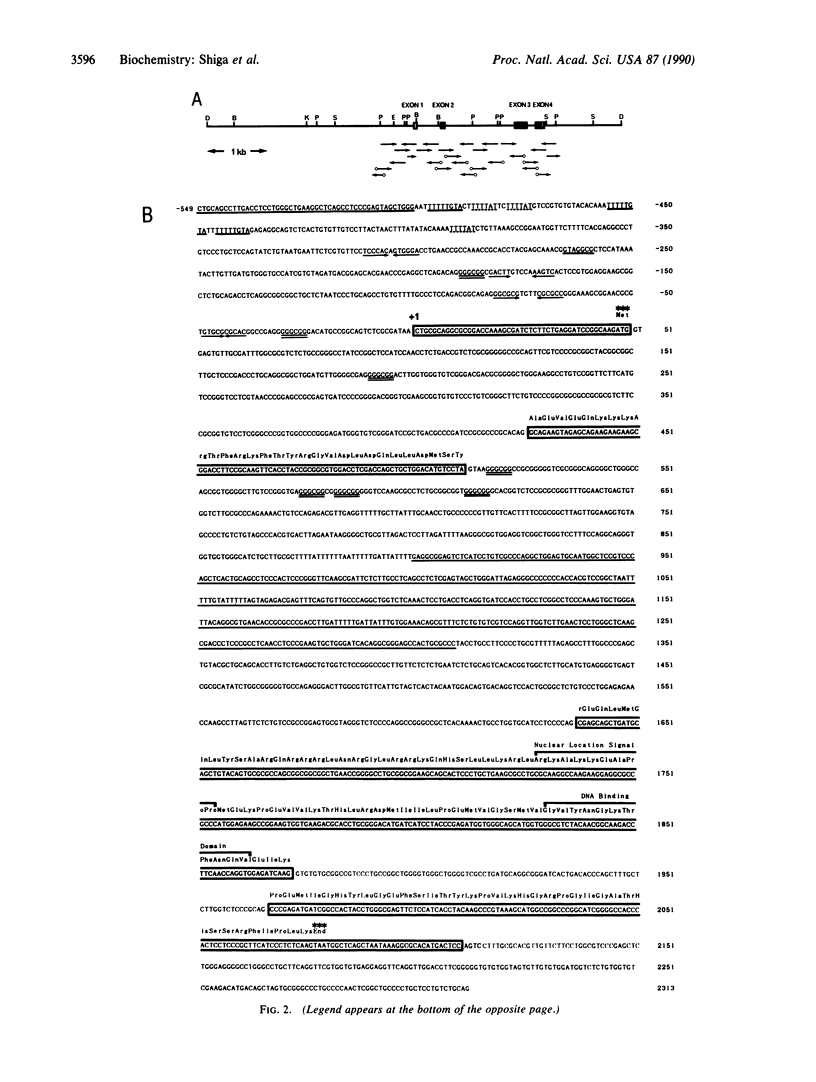
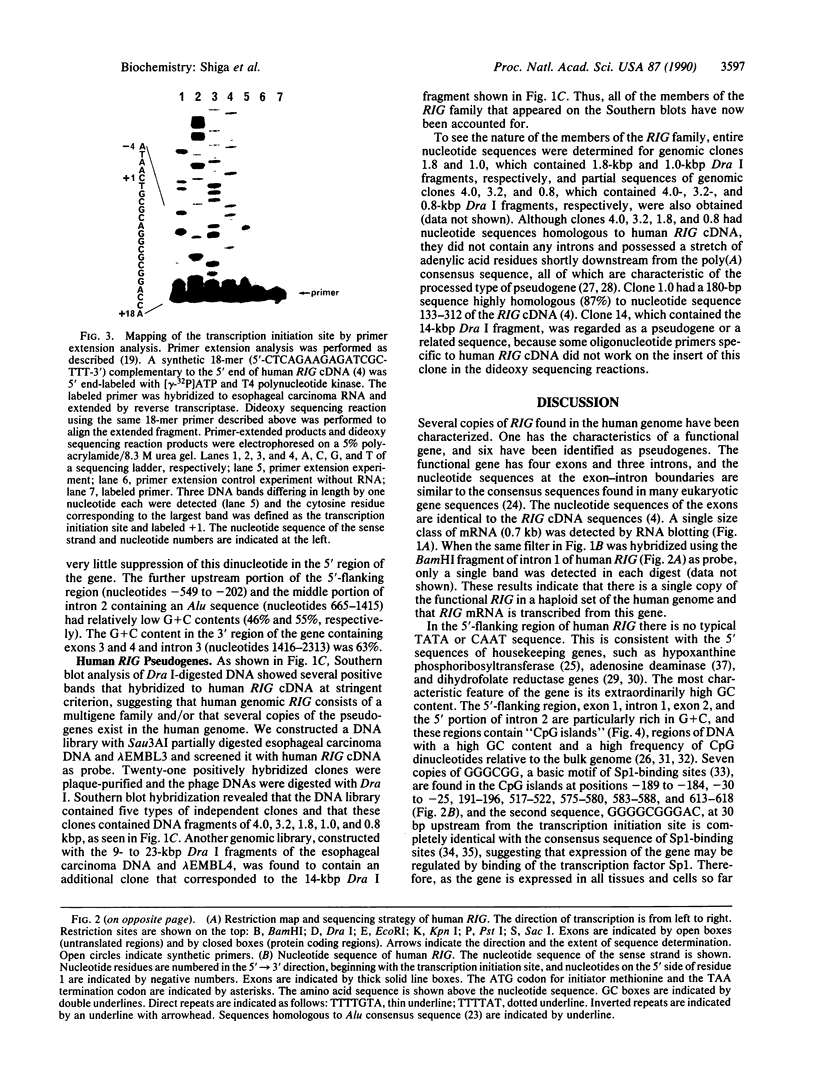
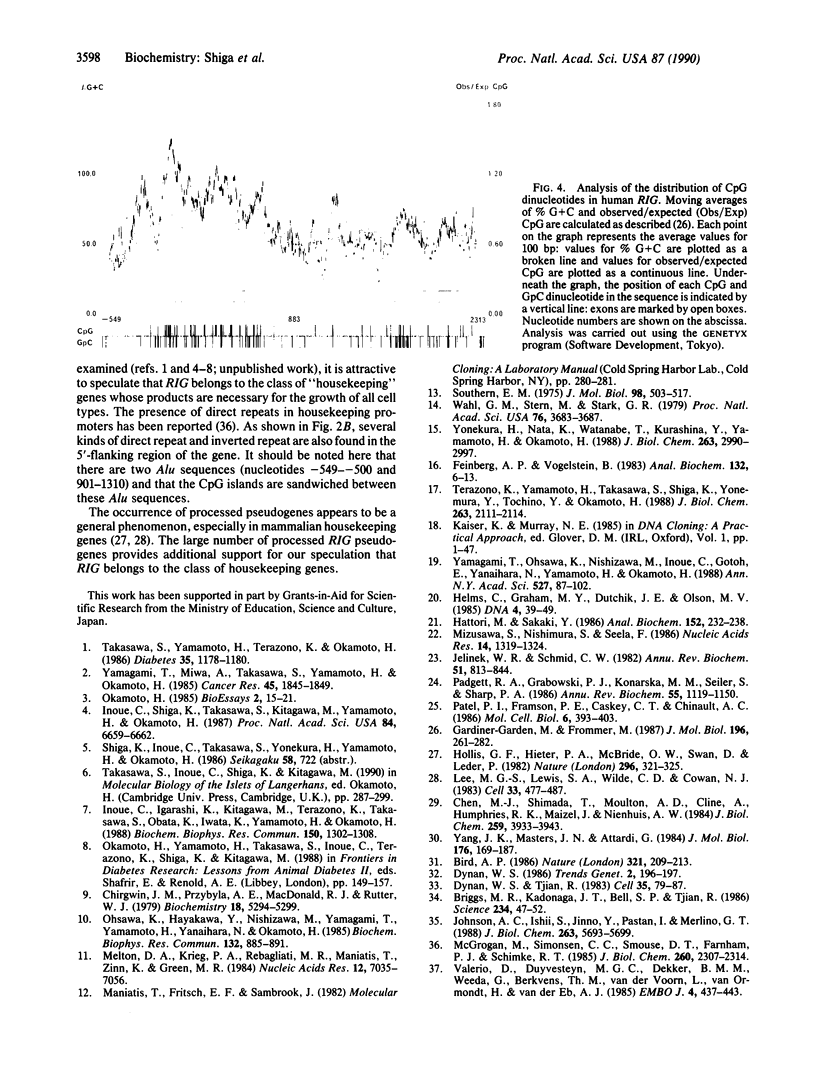
Images in this article
Selected References
These references are in PubMed. This may not be the complete list of references from this article.
- Briggs M. R., Kadonaga J. T., Bell S. P., Tjian R. Purification and biochemical characterization of the promoter-specific transcription factor, Sp1. Science. 1986 Oct 3;234(4772):47–52. doi: 10.1126/science.3529394. [DOI] [PubMed] [Google Scholar]
- Chen M. J., Shimada T., Moulton A. D., Cline A., Humphries R. K., Maizel J., Nienhuis A. W. The functional human dihydrofolate reductase gene. J Biol Chem. 1984 Mar 25;259(6):3933–3943. [PubMed] [Google Scholar]
- Chirgwin J. M., Przybyla A. E., MacDonald R. J., Rutter W. J. Isolation of biologically active ribonucleic acid from sources enriched in ribonuclease. Biochemistry. 1979 Nov 27;18(24):5294–5299. doi: 10.1021/bi00591a005. [DOI] [PubMed] [Google Scholar]
- Dynan W. S., Tjian R. The promoter-specific transcription factor Sp1 binds to upstream sequences in the SV40 early promoter. Cell. 1983 Nov;35(1):79–87. doi: 10.1016/0092-8674(83)90210-6. [DOI] [PubMed] [Google Scholar]
- Helms C., Graham M. Y., Dutchik J. E., Olson M. V. A new method for purifying lambda DNA from phage lysates. DNA. 1985 Feb;4(1):39–49. doi: 10.1089/dna.1985.4.39. [DOI] [PubMed] [Google Scholar]
- Hollis G. F., Hieter P. A., McBride O. W., Swan D., Leder P. Processed genes: a dispersed human immunoglobulin gene bearing evidence of RNA-type processing. Nature. 1982 Mar 25;296(5855):321–325. doi: 10.1038/296321a0. [DOI] [PubMed] [Google Scholar]
- Inoue C., Igarashi K., Kitagawa M., Terazono K., Takasawa S., Obata K., Iwata K., Yamamoto H., Okamoto H. Expression of the insulinoma gene rig during liver regeneration and in primary cultured hepatocytes. Biochem Biophys Res Commun. 1988 Feb 15;150(3):1302–1308. doi: 10.1016/0006-291x(88)90771-1. [DOI] [PubMed] [Google Scholar]
- Inoue C., Shiga K., Takasawa S., Kitagawa M., Yamamoto H., Okamoto H. Evolutionary conservation of the insulinoma gene rig and its possible function. Proc Natl Acad Sci U S A. 1987 Oct;84(19):6659–6662. doi: 10.1073/pnas.84.19.6659. [DOI] [PMC free article] [PubMed] [Google Scholar]
- Johnson A. C., Ishii S., Jinno Y., Pastan I., Merlino G. T. Epidermal growth factor receptor gene promoter. Deletion analysis and identification of nuclear protein binding sites. J Biol Chem. 1988 Apr 25;263(12):5693–5699. [PubMed] [Google Scholar]
- Lee M. G., Lewis S. A., Wilde C. D., Cowan N. J. Evolutionary history of a multigene family: an expressed human beta-tubulin gene and three processed pseudogenes. Cell. 1983 Jun;33(2):477–487. doi: 10.1016/0092-8674(83)90429-4. [DOI] [PubMed] [Google Scholar]
- McGrogan M., Simonsen C. C., Smouse D. T., Farnham P. J., Schimke R. T. Heterogeneity at the 5' termini of mouse dihydrofolate reductase mRNAs. Evidence for multiple promoter regions. J Biol Chem. 1985 Feb 25;260(4):2307–2314. [PubMed] [Google Scholar]
- Melton D. A., Krieg P. A., Rebagliati M. R., Maniatis T., Zinn K., Green M. R. Efficient in vitro synthesis of biologically active RNA and RNA hybridization probes from plasmids containing a bacteriophage SP6 promoter. Nucleic Acids Res. 1984 Sep 25;12(18):7035–7056. doi: 10.1093/nar/12.18.7035. [DOI] [PMC free article] [PubMed] [Google Scholar]
- Mizusawa S., Nishimura S., Seela F. Improvement of the dideoxy chain termination method of DNA sequencing by use of deoxy-7-deazaguanosine triphosphate in place of dGTP. Nucleic Acids Res. 1986 Feb 11;14(3):1319–1324. doi: 10.1093/nar/14.3.1319. [DOI] [PMC free article] [PubMed] [Google Scholar]
- Ohsawa K., Hayakawa Y., Nishizawa M., Yamagami T., Yamamoto H., Yanaihara N., Okamoto H. Synergistic stimulation of VIP/PHM-27 gene expression by cyclic AMP and phorbol esters in human neuroblastoma cells. Biochem Biophys Res Commun. 1985 Nov 15;132(3):885–891. doi: 10.1016/0006-291x(85)91890-x. [DOI] [PubMed] [Google Scholar]
- Padgett R. A., Grabowski P. J., Konarska M. M., Seiler S., Sharp P. A. Splicing of messenger RNA precursors. Annu Rev Biochem. 1986;55:1119–1150. doi: 10.1146/annurev.bi.55.070186.005351. [DOI] [PubMed] [Google Scholar]
- Patel P. I., Framson P. E., Caskey C. T., Chinault A. C. Fine structure of the human hypoxanthine phosphoribosyltransferase gene. Mol Cell Biol. 1986 Feb;6(2):393–403. doi: 10.1128/mcb.6.2.393. [DOI] [PMC free article] [PubMed] [Google Scholar]
- Takasawa S., Yamamoto H., Terazono K., Okamoto H. Novel gene activated in rat insulinomas. Diabetes. 1986 Oct;35(10):1178–1180. doi: 10.2337/diab.35.10.1178. [DOI] [PubMed] [Google Scholar]
- Terazono K., Yamamoto H., Takasawa S., Shiga K., Yonemura Y., Tochino Y., Okamoto H. A novel gene activated in regenerating islets. J Biol Chem. 1988 Feb 15;263(5):2111–2114. [PubMed] [Google Scholar]
- Valerio D., Duyvesteyn M. G., Dekker B. M., Weeda G., Berkvens T. M., van der Voorn L., van Ormondt H., van der Eb A. J. Adenosine deaminase: characterization and expression of a gene with a remarkable promoter. EMBO J. 1985 Feb;4(2):437–443. doi: 10.1002/j.1460-2075.1985.tb03648.x. [DOI] [PMC free article] [PubMed] [Google Scholar]
- Wahl G. M., Stern M., Stark G. R. Efficient transfer of large DNA fragments from agarose gels to diazobenzyloxymethyl-paper and rapid hybridization by using dextran sulfate. Proc Natl Acad Sci U S A. 1979 Aug;76(8):3683–3687. doi: 10.1073/pnas.76.8.3683. [DOI] [PMC free article] [PubMed] [Google Scholar]
- Yamagami T., Miwa A., Takasawa S., Yamamoto H., Okamoto H. Induction of rat pancreatic B-cell tumors by the combined administration of streptozotocin or alloxan and poly(adenosine diphosphate ribose) synthetase inhibitors. Cancer Res. 1985 Apr;45(4):1845–1849. [PubMed] [Google Scholar]
- Yamagami T., Ohsawa K., Nishizawa M., Inoue C., Gotoh E., Yanaihara N., Yamamoto H., Okamoto H. Complete nucleotide sequence of human vasoactive intestinal peptide/PHM-27 gene and its inducible promoter. Ann N Y Acad Sci. 1988;527:87–102. doi: 10.1111/j.1749-6632.1988.tb26975.x. [DOI] [PubMed] [Google Scholar]
- Yonekura H., Nata K., Watanabe T., Kurashina Y., Yamamoto H., Okamoto H. Mosaic evolution of prepropancreatic polypeptide. II. Structural conservation and divergence in pancreatic polypeptide gene. J Biol Chem. 1988 Feb 25;263(6):2990–2997. [PubMed] [Google Scholar]



